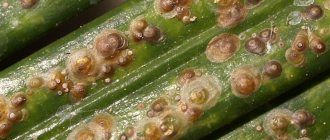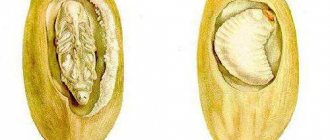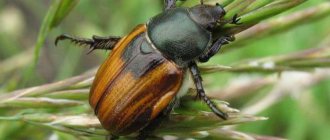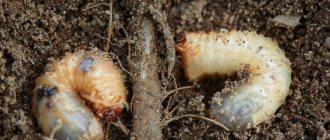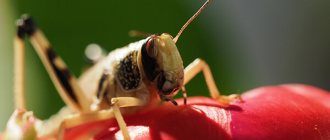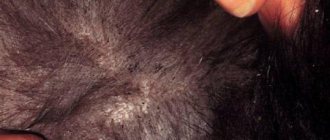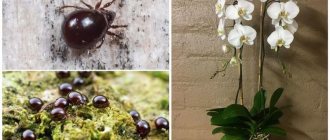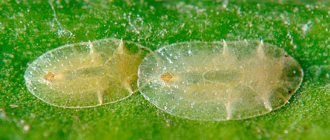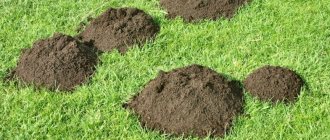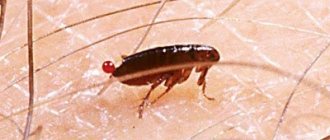Scale insects on house plants, beds or garden trees can cause a lot of trouble. These insect pests damage the leaves, trunks, fruits and branches of many plants. At the height of the gardening season, we fight scale insects competently!
If you find small yellow-brown plaques on your plants, it’s time to sound the alarm. Do not be fooled by their “frivolous” size - in agricultural regions, when some types of these crumbs are discovered, strict quarantine is introduced. In just a few years, scale insects can destroy even a small tree, let alone your orchid or beetroot.
Let's get to know the enemy better so we know exactly how to fight against the scale insect.
Who are scale insects and what do they look like?
Scale insect on a tree.
Scale insects are one of the most dangerous pests that affect various trees and shrubs growing in the garden. Finding them on a tree is quite difficult. The most noticeable are the first and second instar larvae, the so-called strays. They are able to move around the tree and have a bright rim on their body.
Most of the pests on the tree are immobile adult individuals that closely adjoin each other and outwardly resemble a light gray coating. They can be found on the surface of the trunk, main branches, young shoots and leaves.
It is a common misconception that scale insects are large insects. In reality, this is not at all the case, and the average body length of an adult is only 1-4 mm.
Description of pests
Scale insects are coleopterous herbivorous insects, distinguished by their extraordinary gluttony and fertility.
There are more than 2,000 species of these pests, about 150 are common in Europe. They differ in size, color and taste preferences. However, scale insects are not particularly selective - they quickly migrate from plant to plant, neglecting neither weeds nor cultivated species.
A single scale insect is difficult to notice. The size of the pest does not exceed 2.5 mm, the body is flat, round or oval, protected by a dense shield of two larval skins. The color is protective, merging with the surface of the leaf. Depending on the species, the scale insect can be brown, reddish, yellow-green, brown, light yellow, transparent white.
Most species of scale insects lay eggs, but there are also viviparous pests. Insects live on the lower part of plant leaves, forming large colonies. Adults are motionless; recently hatched larvae actively move, choosing new habitats.
During a season, a female can lay up to 1000 eggs. After laying, the adults die, the hatched larvae stick tightly to the veins of the leaves or stem and begin to feed intensively. Gradually, the larvae's limbs die off, and a shield of wax threads is formed. Females completely lose mobility and begin to reproduce. The cycle is repeated many times.
Scale insects are especially active in warm, dry weather, but they can also tolerate short-term frosts. Clutches of eggs laid at the end of the season survive even thirty-degree frosts, and the first larvae hatch at the beginning of spring.
Signs of scale insects appearing on trees
Severe scale infestation can lead to the death of an entire tree, so it is very important to detect the problem in a timely manner and begin to solve it. The main signs of the presence of scale insects are:
- peeling and cracking of the bark;
California scale insect.
- falling leaves;
- death of main branches and young thin branches;
- decreased quality and premature fruit drop;
- complete death of the tree several years after infection.
Rating of affected crops
Scale insects can colonize absolutely any tree or shrub; they can be found in protected ground, in a greenhouse, a winter garden, and even on indoor plants in an apartment. The comma scale insect can settle on:
- apple tree;
- pear;
- plum;
- cherry;
- cherry;
- Quince;
- peach;
- apricot;
- hawthorn;
- mulberry;
- turn;
- cotoneaster;
- rowan;
- currants;
- birch;
- lipa;
- ash;
- lilacs, etc.
At least 150 more plant species belonging to thirteen families can be added to this list. The willow scale insects' tastes extend to trees, shrubs and herbs from 17 families. For some types of scale insects, even toxic compounds that protect certain plants, for example, white dogwood and noble laurel, are not dangerous.
Causes of scale insect infection
The main causes of infestation of fruit trees with scale insects are:
- use of contaminated planting or grafting material;
Scale insect.
- crawling of strays from the branches of an infected tree to the branches of a healthy plant in contact with them;
- irregular crown thinning pruning;
- lack of preventive treatments with insecticides;
- violation of agrotechnical rules.
Preventive measures
Treatment of peaches against various pests is carried out not only for protection, but also for prevention. The following factors can also prevent the appearance and reproduction of insects:
- regular pruning of dry, damaged shoots;
- timely collection and burning of fallen leaves and fruits;
- systematic weeding;
- destruction of root shoots;
- regular loosening of the soil around the trunk;
- autumn sanitary pruning.
To prevent peach pests, treatments with the following preparations are effective:
- Confidor at the pink bud stage from aphids, fruit moths, leaf rollers;
- Sunmite against ticks two weeks after flowering;
- Coragen against codling moths and fruit moths in the summer at the peak of the appearance of butterflies, again after 2.5-3 weeks;
- Lufox for codling moths and fruit moths 2.5-3 weeks after repeated treatment with Coragen, again after 20 days as necessary.
In the spring, to prevent the appearance of scale insects, you can use a tobacco-soap infusion:
- Pour 0.4 kg of tobacco with a liter of water, leave for 24 hours;
- Boil the mixture and add 50 g of regular soap.
- Boil for five minutes, add 11.5 liters of water.
- Spray peach trees.
Many pests are repelled by strong odors. Next to the peaches you can plant mint, lemon balm, lavender and other aromatic plants.
Methods for combating scale insects
Fighting scale insects is not an easy task. Adults are reliably protected by a durable shield from the effects of various insecticides and treatment with folk remedies, and yet, there are many effective methods of combating these harmful insects.
Mechanical method
This method is only suitable for the initial stage of infection. While the number of insects is small, they can be removed from the surface of the branches using a toothbrush or a hard sponge dipped in an alcohol-containing liquid.
It would be wiser to cut down or prune severely affected branches and shoots.
Folk recipes
Shield.
Among folk methods, there are a large number of effective and time-tested recipes. Infusions of plants such as:
- tobacco;
- celandine;
- garlic.
To improve the effect, the resulting infusions should be mixed with a soap solution. The main disadvantage of such products is their weak effect on adults.
Biological method
This method is considered quite effective and environmentally friendly, since it involves the use of fungicidal preparations based on pathogenic fungi and nematodes to combat scale insects.
The most popular fungicides are Nemabact and Aversectin.
Chemicals
The modern market also offers a wide range of effective chemicals. The following preparations are most popular among gardeners:
- Ditox;
- Binomial;
- Fufanon;
- Calypso.
Chemicals
When it rains for days, the strawberry harvest melts before our eyes, and with it the labor of using improvised means, heavy artillery enters the battle. There are a number of products that protect the health of green mass and berries, which can be used even several weeks before harvest without fear for your own health.
Advantages:
- Work quickly, effect after first use
- Effective in heavy rain on all types of soil
- At the same time, other pests are destroyed
- Relatively low cost
- Convenient to use over large areas
Flaws:
- It is important to follow the dosage and manufacturer’s recommendations regarding processing and its frequency.
Expert opinion Stefania Bogdanovna Mityuk Each specific product has its own instructions for use, where the manufacturer indicates the optimal dosage for applying the poison, as well as the frequency of etching. Precautions should be strictly observed and a less toxic product should be chosen.
Fitoverm
An absolutely natural product that consists of living soil microorganisms. When they enter the soil, they increase the number of beneficial bacteria, and their waste products are destructive to weevils, caterpillars, aphids and fleas.
The liquid preparation is diluted in water and sprayed on the leaves and ground in dry, warm weather. Prevention is carried out once a month from the moment the first shoots appear.
Biokill
According to people who grow strawberries on an industrial scale, Biokil is the best drug known today. The complex insecticide effectively destroys weevils, aphids and other pests, breaking down into safe radicals that do not accumulate in the soil and plants. The key advantage is the ability to process 3 days before harvest. The manufacturer assures that the product is absolutely safe.
Aktara
This insecticide has a wide spectrum of effects, destroying all pests in the soil and on its surface. The contents of the sachet must be dissolved in water and sprayed according to the instructions. Usually one treatment is enough to completely eradicate the weevil. The drug should be used in early spring, as it can penetrate plants and accumulate in the soil.
Preventing the appearance of scale insects on trees
It is very difficult to get rid of scale insects that have infected a tree, so you should carefully monitor the condition of the plant and take all necessary preventive measures. To prevent the appearance of this dangerous pest in the garden, you must adhere to the following recommendations:
- purchase seedlings and grafting material only from trusted sellers, and also carefully inspect them before purchasing for infection;
What products do you prefer to use in the garden?ChemicalFolk
- promptly remove and destroy infected tree branches;
- Every year in the autumn, remove exfoliated and dead bark from the trunk and branches;
- periodically treat trees with specialized preventative agents.
- regularly thin out the crown;
- Feed the tree with fertilizers in a timely manner to maintain strong immunity.
Why are they dangerous?
Like other leaf-sucking and leaf-gnawing pests, scale insects feed on plant juices.
They prefer succulent young shoots, making no difference between weeds and cultivated plants. With extensive lesions, the leaves begin to fall off, the plant weakens, and cannot form fruit ovaries. The sticky liquid secreted by insects blocks the access of oxygen and disrupts the process of photosynthesis.
Moving from plant to plant, flying male scale insects and active larvae carry fungi and viruses that cause a variety of diseases that are difficult to treat.
Expert opinion
Mityuk Stefania Bogdanovna
The not completely destroyed scale insect can manifest itself next year, attacking the garden and vegetable garden with the first warm days. The more parasites there are in an area, the more difficult it is to get rid of them. In severe cases, some gardeners completely destroy the affected plants, replacing them with new ones.
